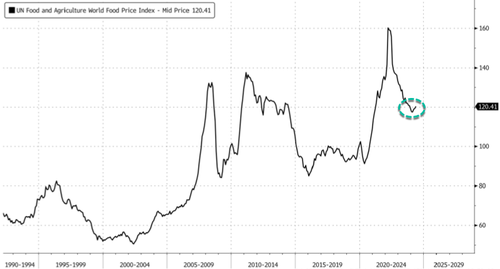Global Food Prices Rise For Third Straight Month, Fueling Instability Risks In Developing World
The Food and Agriculture Organization of the United Nations (FAO) reported that global food prices increased for the third consecutive month in May. This rise was driven by higher prices for cereals and dairy products, which outweighed declines in sugar and vegetable oil prices. The re-acceleration of food price growth should be a cause for concern among policymakers.
The FAO Food Price Index, which tracks the international prices of a basket of globally traded food, averaged 120.4 in May, marking a .9% increase from its revised April level. Despite this rise, the index is still 3% lower than a year ago and 24.9% below its peak in March 2022. However, the index has reserved some losses over the past several months and turned higher.
FAO: Month-over-Month Percentage Change
FAO: Year-over-Year Percentage Change
The uptick in May was driven by cereal prices jumping 6.3% month-over-month due to growing concerns in key farming areas in northern America, Europe, and the Black Sea region. Dairy prices rose 1.8% from May to April, the FAO said.
Sugar prices dropped 7.5% monthly in May, and vegetable oil prices fell 2.4%.
The FAO warned, “The recent adverse weather conditions in the Black Sea region will likely result in a downgrade in world wheat production, a possibility not yet reflected in the forecast.”
The bigger story here is global food prices are beginning to rise once again. This is potentially catastrophic for emerging market economies where currencies are moving lower and, inversely, food prices are moving higher. Folks in these countries have to allocate higher percentages of their incomes to food purchases, and the increase in that only produces financial stress. In return, higher food prices increase the risk of social instability.
Tyler Durden
Tue, 06/11/2024 – 13:05

